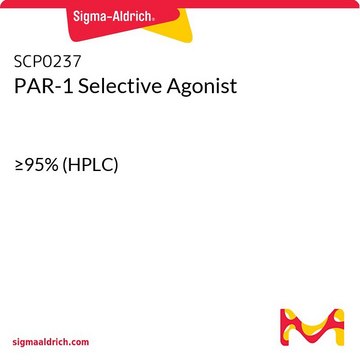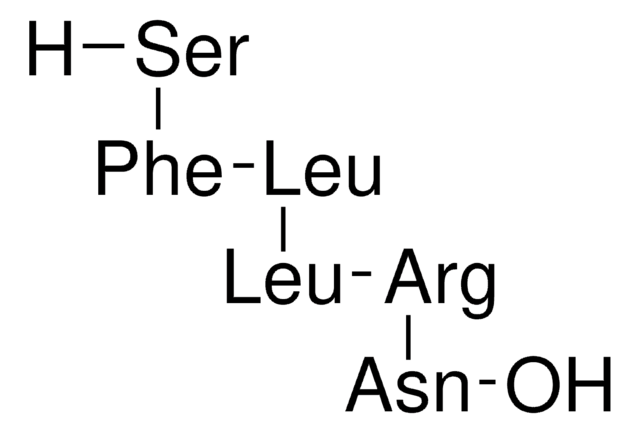T7830
TFLLR-NH2 trifluoroacetate salt
>98% (HPLC)
别名:
L-Threonyl-L-phenylalanyl-L-leucyl-L-leucyl- L-argininamide trifluoroacetate salt, Thr-Phe-Leu-Leu-Arg-NH2 trifluoroacetate salt
About This Item
推荐产品
化驗
>98% (HPLC)
形狀
lyophilized powder
顏色
white to tan
溶解度
H2O: >2 mg/mL
儲存溫度
−20°C
SMILES 字串
OC(=O)C(F)(F)F.CC(C)C[C@H](NC(=O)[C@H](CC(C)C)NC(=O)[C@H](Cc1ccccc1)NC(=O)[C@@H](N)[C@@H](C)O)C(=O)N[C@@H](CCCNC(N)=N)C(N)=O
InChI
1S/C31H53N9O6.C2HF3O2/c1-17(2)14-22(27(43)37-21(26(33)42)12-9-13-36-31(34)35)38-28(44)23(15-18(3)4)39-29(45)24(16-20-10-7-6-8-11-20)40-30(46)25(32)19(5)41;3-2(4,5)1(6)7/h6-8,10-11,17-19,21-25,41H,9,12-16,32H2,1-5H3,(H2,33,42)(H,37,43)(H,38,44)(H,39,45)(H,40,46)(H4,34,35,36);(H,6,7)/t19-,21+,22+,23+,24+,25+;/m1./s1
InChI 密鑰
QVNWOGSDGQDGHP-MKVNCOEFSA-N
Amino Acid Sequence
應用
生化/生理作用
準備報告
儲存類別代碼
11 - Combustible Solids
水污染物質分類(WGK)
WGK 3
閃點(°F)
Not applicable
閃點(°C)
Not applicable
其他客户在看
我们的科学家团队拥有各种研究领域经验,包括生命科学、材料科学、化学合成、色谱、分析及许多其他领域.
联系技术服务部门







